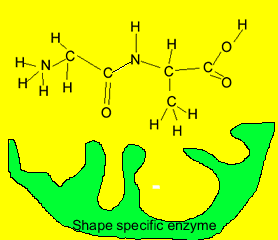Protein shape and function
Enzymes

The animation above shows an enzyme catalyzing the hydrolysis of a peptide bond. Note the specific shape which allows the substrate (reactant molecule) to sit exactly in a certain orientation that will allow bonds to be broken with less activation energy. Some active sites have small inorganic parts called cofactors. Cofactors sit in the active site and assist with the catalysis of the reaction. They are usually metal atoms or vitamins.
Enzymes are Nature's own catalysts. Just like inorganic catalysts they speed up the rate of reaction by lowering the activation energy required for a particular reaction. However, unlike inorganic catalysts, enzymes are specific to a particular reaction and operate at much lower temperatures than inorganic catalysts
At high temperatures enzymes and proteins in general, are denatured. Their shape is destroyed as the heat overcomes the bonds that keep the structure in tact. This also happens when the pH falls outside the narrow range tolerated by the body.
Enzymes have a special region on their surface that is known as the active site. The active site is usually a cavity or flexible depression in the surface of the protein. The shape of the active site is crucial in the catalysis of specific reactions.